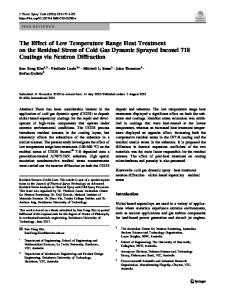The Influence of the Support Structure on Residual Stress and Distortion in SLM Inconel 718 Parts
- PDF / 7,849,037 Bytes
- 9 Pages / 593.972 x 792 pts Page_size
- 21 Downloads / 444 Views
NTRODUCTION
SELECTIVE laser melting (SLM) is a powder-bed-based additive manufacturing (AM) technique which gives the possibility of producing near-net shape structures with complex geometry and good mechanical performance.[1] The fabrication of comparable complex components with conventional manufacturing techniques needs more effort and creates much more wastes, if it is even possible.[2] For the AM processes, however, powder characterization, the component tailored optimization of microstructure, mechanical properties and design, as well as process quality control need to be done at every step of manufacturing.[3,4] Furthermore, due to
TATIANA MISHUROVA, TOBIAS THIEDE, NARESH NADAMMAL and ARNE KROMM are with the Bundesanstalt fu¨r Materialforschung und –pru¨fung (BAM), Unter den Eichen 87, 12205 Berlin, Germany. Contact e-mail: [email protected] SANDRA CABEZA is with the Institut Laue-Langevin, 71 Avenue des Martyrs, 38000 Grenoble, France and also with the Bundesanstalt fu¨r Materialforschung und –pru¨fung (BAM). MANUELA KLAUS and CHRISTOPH GENZEL are with the Helmholtz-Zentrum Berlin fu¨r Materialien und Energie GmbH, Hahn-Meitner Platz 1, 14109 Berlin, Germany. CHRISTOPH HABERLAND is with the Siemens AG, Power and Gas, Huttenstrasse 12, 10553 Berlin, Germany. GIOVANNI BRUNO is with the Bundesanstalt fu¨r Materialforschung und –pru¨fung (BAM) and also with the Institute of Physics and Astronomy, University of Potsdam, Karl-Liebknecht-Str.24-25, 14476 Potsdam, Germany. Manuscript submitted November 10, 2017.
METALLURGICAL AND MATERIALS TRANSACTIONS A
the multi-layer deposition technique, complex residual stress (RS) fields typically are present in SLM parts. The origin of RS has been identified as the high thermal gradients during SLM, and discussed in Reference 5. During the manufacturing process, the top layer expands, while the previous layers cool down. Extending this phenomenon to a multi-layer finally leads to large thermal gradients along the building direction. Therefore, delamination and cracks have been observed even during production.[6] The stress-relieving heat treatment after production cannot solve the problem of the thermal cracks and distortion during manufacturing. Therefore, the problem needs prevention rather than cure: the scanning parameters and the scanning strategy need to be optimized. Thermal gradients are highly affected by manufacturing parameters.[7] The influence of the scanning strategy on RS state has been reported in several studies.[5,8–11] In the last work, the authors have discussed a decrease in RS by island scanning strategy, which consists of scanning small square-shaped areas. A support structure can prevent cracking and compensate distortion due to high RS. Support structures are especially useful for overhanging features[4] since they bear the weight of the part as well as compensate the distortion along the horizontal direction. Besides, a support structure facilitates heat dissipation, since a loose powder has very poor thermal conductivity. Also, it plays a role o
Data Loading...











